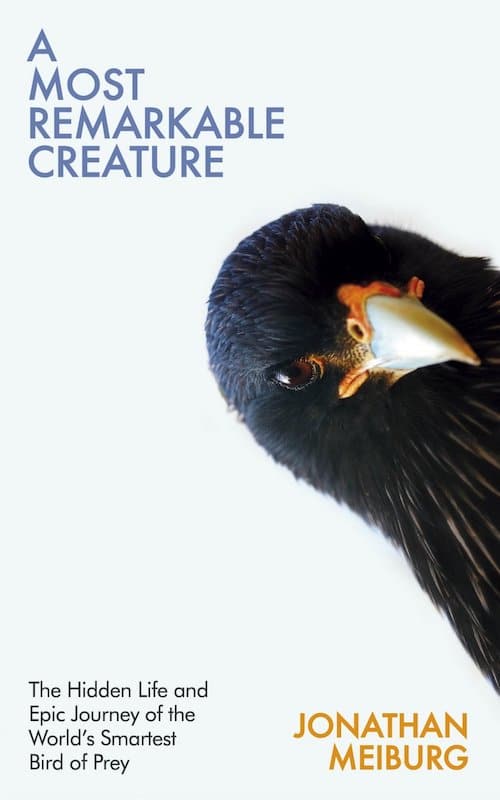| A Most Remarkable Creature – The Hidden Life and Epic Journey of the World’s Smartest Bird of Prey | Jonathan Meiburg | The Bodley Headf | 2021 | Hardback | 400 Pages | 16 Colour Plates | ISBN: 9781847923561 | £24.99p |

The Publisher’s View:
In 1833, a young Charles Darwin was astonished by a strange animal he met in the Falkland Islands: a set of handsome, social, and oddly crow-like falcons that were “tame and inquisitive”, “quarrelsome and passionate”, and so insatiably curious that they stole hats, compasses, and other valuables from the crew of the Beagle. Darwin met many unusual creatures in his five-year voyage, but no others showed an interest in studying him, and he wondered why these birds were confined to remote islands at the tip of South America, sensing a larger story.
But he set this mystery aside, and never returned to it; and almost two hundred years later, Meiburg picks up where Darwin left off. These birds – now called striated caracaras – still exist, though they’re very rare; and A Most Remarkable Creature reveals the wild and fascinating story of their history, origins, and possible futures in a series of travels throughout South America, from the fog-bound coasts of Tierra del Fuego to the tropical forests of Guyana. Along the way, Meiburg draws us into the life and work of William Henry Hudson, the Victorian naturalist who championed caracaras as an unsung wonder of the natural world; and takes us to falconry parks in the English countryside, where captive birds perform incredible feats of memory and problem-solving.
A Most Remarkable Creature is a hybrid of science writing, travelogue, and biography, as generous and accessible as it is sophisticated, and much more than a book about birds: it’s a journey to uncover moments of first contact between humans and animals, science and religion, and the mismatched continents of what Europeans mistakenly called the New World.
The Author: Jonathan Meiburg is a writer, ornithologist, and adventurer who’s best known as the singer of the band Shearwater. His pieces on science, nature, and music have appeared in The Believer, Talkhouse, and The Appendix. His unique career between the sciences and the arts makes him an ideal guide for a journey that takes in the deep history and landscapes of an entire continent, from the lush forests of Guyana to the windswept Falkland Islands. He lives in central Texas.
Fatbirder View:
Generally speaking, I’m not a huge fan of monographs, or even those books about all the species of a genus or other sub group. There are ten thousand plus species out there and, although I would love to see them all, I’ve always felt that diving too deep into any one is more likely to turn you off their charms than to endear them to you. I want to know stuff about the birds I see daily and a little about any there are, but depth tends to be rather dry and technical. However, I’m open to persuasion.
What persuaded me to delve into this book was two things. Firstly, it is very beautifully written. There is a long and noble list of writers on natural history subjects that weave wonderful word pictures as well as giving accurate accounts whether it be Gilbert White or Chris Packham, and Jonathan Meiburg has followed this tradition, making the book both accessible and enjoyable on the level of literature.
Secondly, it draws a lot from another naturalist whose love of the subject matter matched that of the author. William Hudson* is a sadly neglected naturalist. In his time, he was ranked with the giants, both scientific and literary.
So, I was intrigued enough to read on and am glad I did. I have seen just a few Caracaras and always in groups which, in itself, is unusual for birds of prey. They are certainly striking, and, now I know, right up there as members of the avian equivalent of MENSA.
I recommend you join that journey too.
Extracted from my Eponym Dictionary of Birds:
Hudson, WH
Hudson’s Black Tyrant Knipolegus hudsoni PL Sclater, 1872
Hudson’s Canastero Asthenes hudsoni PL Sclater, 1874
[Alt. Hudson’s Soft-tail]
William Henry Hudson (1841-1922) was born in Buenos Aires to American parents. He spent his childhood on the pampas but a heart condition forced his emigration to England (1870). He is generally regarded as a British author, naturalist and ornithologist. However, he is best known for his exotic romances, especially: Green Mansions (1904), which is set in a South American jungle. His memoir: Far Away and Long Ago (1918) lovingly recalls his childhood. Hudson was a sensitive observer of nature, particularly birds. He hated the vogue for ‘collecting’ birds and once said of John Gould (q.v.) that his obsession with hummingbirds was not the selfless appreciation of a true lover of nature, but no more than a magpielike addiction: “He regarded natural history principally as a science of dead animals – a necrology.” Whilst he met Gould only once (c.1875), he wrote a satirical pamphlet about him and described him as a ‘pretentious and unscientific ornithologist’. His books describe plants and animals in a highly personal manner with great force and beauty. Other works are: The Purple Land (1885), Argentine Ornithology (1888), The Naturalist in La Plata (1892), A Shepherd’s Life (1910) and A Hind in Richmond Park (1922). The novelist John Galsworthy said of him: “Hudson is … the finest living observer, and the greatest living lover of bird and animal life, and of Nature in her moods.”
Fatbirder
